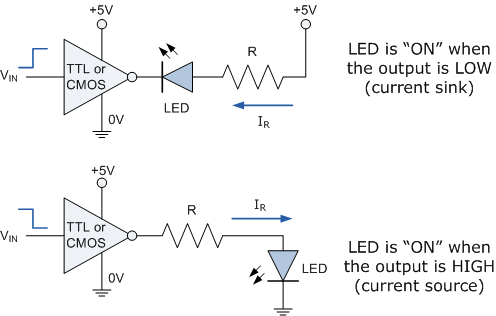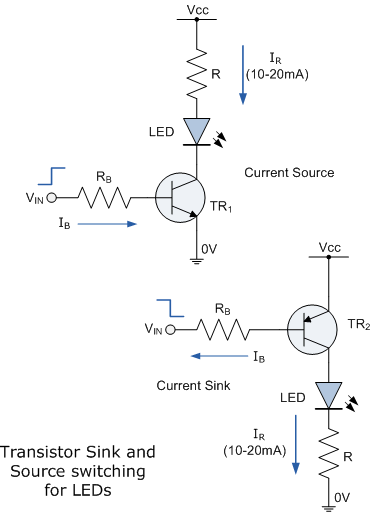LED Driver Circuits
As now we know that what is LED, we need some method of controlling it by switching it "ON" and "OFF". The output stages of TTL and CMOS logic gates can both source and sink the useful quantity of current thus can be used to drive an LED. The normal integrated circuits (ICs) have output drive current of up to 50mA in sink mode configuration, but have an internally restricted output current of around 30mA in the source mode configuration. In either way the LED current should be limited to a safe value using a series resistor as we have seen already. Under are some examples of driving the light emitting diodes using inverting ICs but the idea is same for any type of integrated circuit output whether combinational or sequential.
IC Driver Circuit

If more than one LED requires driving at the same time, such as in large LED arrays, or the load current is to high for the integrated circuit or we may just want to use discrete components instead of ICs, then an alternative way of driving the LEDs using either bipolar NPN or PNP transistors as switches is given below. Again as before, a series resistor, RS is required to limit the LED current.
Transistor Driver Circuit

Brightness of the light emitting diode cannot be controlled by varying the current simply flowing through it. Allowing more current to flow through the LED will make it glow brighter but will be the reason of it to dissipate more heat. LEDs are designed to produce a set amount of light operating at a specific forward current ranging from about 10 to 20mA. In situations where power savings are essential, less current may be possible. However, reducing the current to below say
5mA may dim its light output too much or even turn the LED "OFF" entirely. A much better method to control the brightness of LEDs is to make use of a control process called as "Pulse Width Modulation" or PWM, in which LED is repeatedly turned "ON" and "OFF" at the varying frequencies depending upon the needed light intensity.
Email based Electronics Devices and circuits assignment help - homework help at Expertsmind
Are you searching Electronics Engineering assignment help expert for help with LED Driver Circuit questions? LED Driver Circuit topic is not easier to learn without any external help? We at www.expertsmind.com offers free lecture notes for Electronics Devices and circuits assignment help and Electronics Devices and circuits homework help. Live tutors are available 24x7 hours for helping students in their LED Driver Circuit related problems. We provide step by step LED Driver Circuit question's answers with 100% plagiarism free content. We prepare quality content and notes for LED Driver Circuit topic under Electronics Devices and circuits theory and study material. These are avail for subscribed users and they can get advantages anytime.
Why Expertsmind for assignment help
- Higher degree holder and experienced experts network
- Punctuality and responsibility of work
- Quality solution with 100% plagiarism free answers
- Time on Delivery
- Privacy of information and details
- Excellence in solving electronics engineering questions in excels and word format.
- Best tutoring assistance 24x7 hours